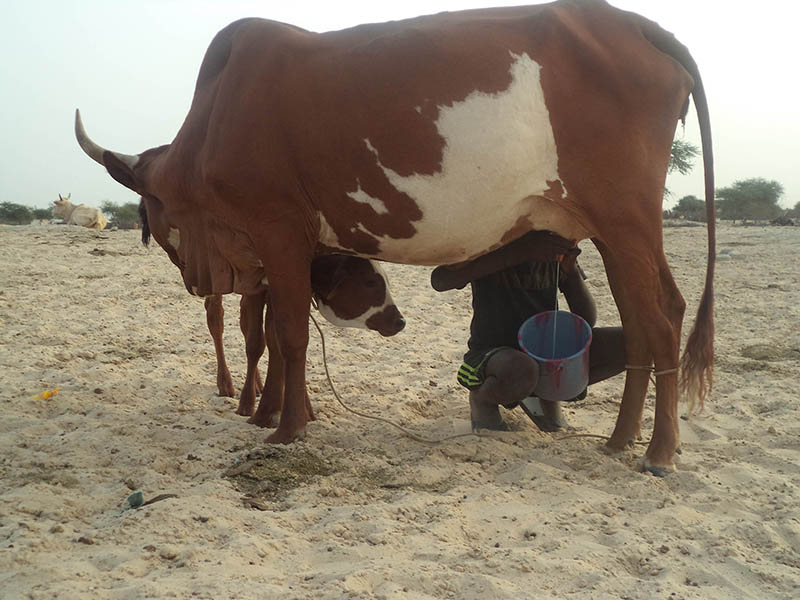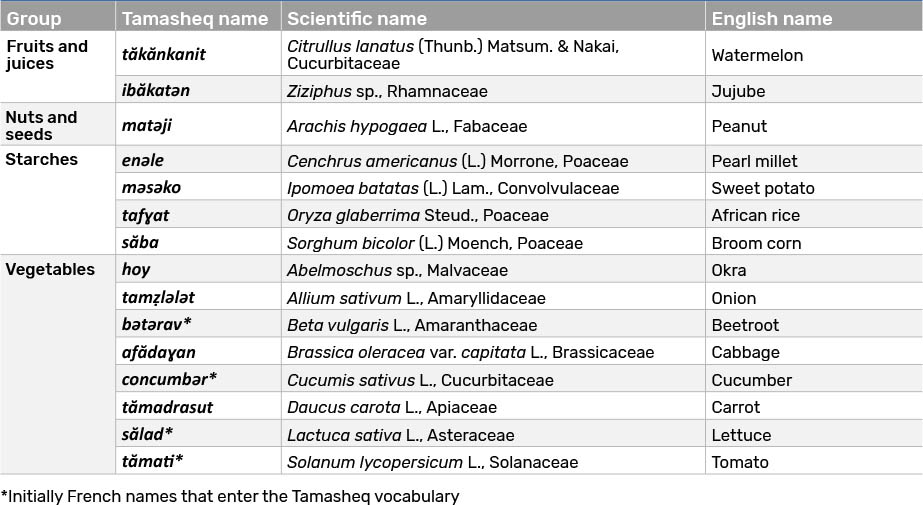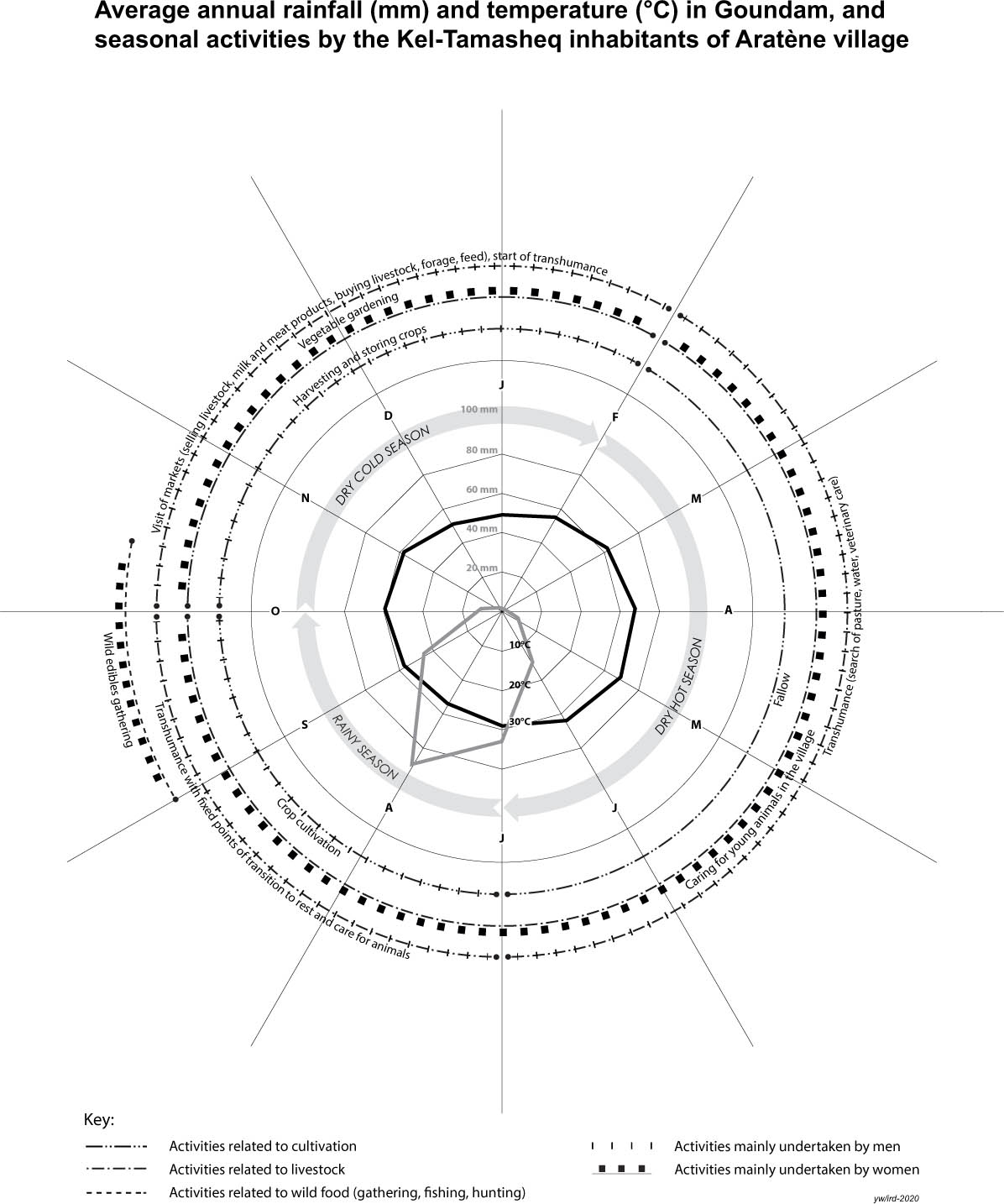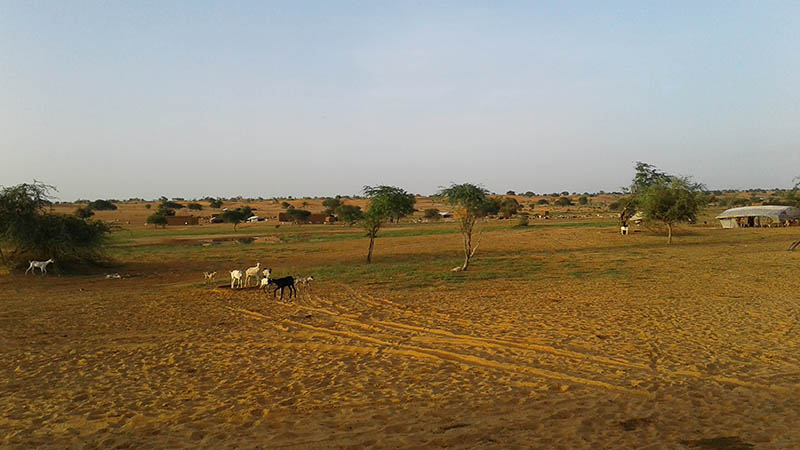Chapter 5. Surviving in the desert: the resilience of the nomadic herders Pastoralist food system of the Kel Tamasheq people in Aratène, Mali
Section 1 Community and food system profile
1. GEOGRAPHIC CONTEXT
The village of Aratène is located 55 km southwest of Gargando, the main town in the commune with an eponymous name. The commune of Gargando, in Goundam Circle in the Timbuktu region, is part of the lacustrine plain of the Lake Faguibine System. The Lake Faguibine System consists of five interlinked lakes filled by two channels effluent of the Niger River. Lake Télé is located a few kilometres north of the town of Goundam. In the past, it provided the town with the water it needed for its seasonal pastoralism and agricultural activities, but it has now become a vast expanse of land that is unworkable for agriculture. The community’s boundaries have been fixed due to its borders to the north by the commune of Raz El Ma, to the south by the commune of Armarzaga, to the east by the commune of Gargando, and to the west by the commune of Tignère.
The area has a Sahel Saharan climate that is characterised by fluctuating temperatures that are as high as 45 °C in May-June and as low as 11 °C in January. The atmospheric circulation consists predominantly of the harmattan trade winds and the West African monsoon circulations. The average annual rainfall recorded in Aratène is the same as that in the Lake Faguibine System, ranging between the isohyets of 100 mm/year and 300 mm/year. Alternating years of good rainfall and years of drought have resulted in irregular years of rich yield and years of food uncertainty. The Sahel-type ecosystem is characterised by sparse and withered vegetation, made up of shrubs and thorn bushes, in particular, acacias (Acacia sp., Fabaceae), desert dates (Balanites aegyptiaca), jujubes (Ziziphus sp.), milkweeds (Calotropis sp., Apocynaceae) and spurges (Euphorbia sp., Euphorbiaeae), which dominate the most diverse grasses.

Source: RPPS, 2018.
2. LOCAL DEMOGRAPHICS AND SOCIAL ORGANIZATION
The Kel Tamasheq people (also called Tuareg), who came from the east and from the Sahara, are considered to be the first ethnic settlement group to have visited the Gargando region. They are divided into three distinct socio-political entities or tribes, namely: (1) the Kel Antessar tribe, roaming in the north, in the area near the Lake Faguibine System; (2) the Tenguereguif tribe, roaming between Timbuktu and Goundam and in the river basin during the dry season; and (3) the Kel Hausa or Cheriffen, who are exclusively marabouts and whose families are related to the first two groups. According to sources, Aratène was established by a Kel Antessar fraction who lived there and who used it for their area of transhumance. Two Kel Tamasheq communities, both black and white, make up the village community: the white Kel Tamasheq and the black Kel Tamasheq.31 In nomadic areas, any settlement exceeding 100 people can establish itself as a fraction. Like the village, the fraction is a base unit of the local authority. The current village population is estimated at 3 000 inhabitants, according to the General Population and Housing Census carried out by the National Statistics Institute of Mali (INSTAT) in 2009. Tamasheq is the local language; and it is also the only language used to communicate between the populations. Islam is the only local religion.
The community is organised in such a way that the family nucleus is extended to close relatives, who are uncles, nephews, cousins, aunts and grandparents. Women take care of household chores, process food to produce by-products, and often deal with picking and small-scale trade. Men practise transhumance and deal with transport, blacksmithing, and cultivating crops and vegetables. Other family members consult them on all family matters or projects. The village chief is the leader of the community and is assisted by other traditional leaders or notable persons and fraction leaders. Key decisions that affect the community’s livelihood are made after consulting the village chief, along with notable persons and fraction leaders. The village chief’s authority covers the entirety of the village, whereas the fraction leader’s only concerns are his fraction.
3. LOCAL FOOD PRODUCTION
The Kel Tamasheq community’s food system is mainly based on pastoralism: milk and meat production and their by-products such as curd, butter and cheese, as well as dry-cured spicy salted meat (smoked meat). These primary food groups, which constitute the Kel Tamasheq’s core diet, are passed on through generations. The Kel Tamasheq community self-identifies through these food items and their unique local processing methods. Livestock herding is part of a pastoralist production system, characterised by mobility, namely transhumance and nomadism. The Kel Tamasheq food system includes other subsistence activities such as cereal and vegetable farming, as well as wild food gathering.
Livestock
In Aratène, pastoralist livestock herding remains the main activity and is also the main source of income of the community members. Their income is generated by selling animals, due to the absolute necessity, and also by selling derivatives such as milk, meat and their by-products. The species bred are sheep, goats, cattle, donkeys, camels and poultry (Table 5.1). Donkeys are bred to transport people, building materials and firewood. The community does not use their meat or milk for consumption.

Trees, grasses, livestock feed, bourgou (Echinochloa stagnina (Retz.) P. Beauv., Poaceae) fodder, rice, wheat, starches, salt and mineral lick stones are all used to feed the animals. This type of livestock herding is based on transhumance and nomadism, with these mechanisms complementing each other. Transhumance is based on the exploitation of the pastures and water sources available according to a specific itinerary and calendar pattern dictated by the alternating seasons. Nomadic/mobile pastoralism is characterised by constant movements that follow pastures and water availability without being tied to a fixed point. Transhumance and nomadism are regulated by seasonal short- and long-distance mobility. Beyond the fact that it is a production system essential for their subsistence because it enables a rational use of natural resources, mobility is an inherited ancestral cultural value based on a strong emotional relationship between the pastoralist and his animal, and which contributes to the social construction of pastoralist societies. The herd represents everything: strength, life, food, but also, and perhaps above all, prestige and peer admiration. Hence the propensity for numbers to grow. The average herd size varies depending on the species. It varies from (1) 20 heads for bovine, with a male/female ratio of 1:20; (2) 50 heads for ovine and caprine with a ratio of 4:50; or (3) 5 heads for camels with a ratio of 1:5. Animal owners keep their livestock numbers a secret. It is a taboo subject during livestock surveys in certain areas of Mali. Traditionally, one must not, under any circumstances, violate this secret for two reasons: (1) bank account concept: asking the herder how many animals are in his herd is like asking an employee, with fixed or variable income, how much money they have in their bank account; and (2) livestock tax: which has definitely made farmers more wary.
Milk is a product that has both economic and cultural significance for pastoralists. It is perceived as the most appreciated and vital food product for its numerous nutritive properties. On average, good milk producers provide up to 10 litres per day in two milking sessions. This drops to 6 litres in the dry season. Milk is stored in goatskins, both amongst families and during the transhumance period. Processing it enables community members to obtain by-products such as curd, butter from cow’s milk, and cheese from goat and sheep’s milk. Cheese making consists of mixing, in a wooden bowl, fresh milk and a piece of abomasum (last sac of a ruminant’s stomach) from a young goat, which might have been slaughtered for the occasion. After the milk is fermented, the mixture is poured through a wooden press that is weaved locally by the women. The pressure separates the milk from the cheese curd. Meat is processed by drying it in the sun or in the shade with salt and spices. To make large quantities, a young bull might be slaughtered. The meat is placed on a wooden shed for sun drying, and when dry, the meat is hung in the shade on cords weaved by local artisans. Dried meat can be ground and stored in gourds made by local artisans. To enable preservation up to one year, butter can be added to the dried meat, as well as honey optionally. Honey comes from the south of Mali and is therefore purchased from the market. The gourd is then air-tightly sealed to prevent air access. Curd, butter and cheese are the by-products sold at the market.

©RPPS.
Transhumance can last six months. Family leaders decide when it starts based on information obtained beforehand from observers who have gone scouting to check water and pasture conditions. Men own their livestock and manage the herd, the arrival and departure of animals, milk deliveries, food and veterinary medication purchases, etc. In contrast, women own the milk and manage the income generated from its sale. Women are also responsible for processing milk and meat as well as gathered wild edibles. Depending on production levels, they decide how much is for family consumption, for processing, for selling, for stocking, and for donating to the poor or to parents in the larger towns. Women also look after small animals and poultry. Children play their role in the community by looking after young animals, such as calves, goat kids and lambs, and by going to school.
Crops
For the Aratène’s pastoralist community, cultivating cereal crops is a random activity that exemplifies amateurism. Cultivation activities focus on three crops: pearl millet, broom corn and rice, all of which are rain-fed and do not require irrigation. The surface area of these rain-fed plots occupy between 1 and 1.5 ha of land. The community members carrying out these activities use the plots depending on their needs and their abilities, taking into account the interests of others and the shared ownership, as the land does not belong to anyone. Production methods are rudimentary. The women process millet into cream. The process consists of grinding the grains down to flour, which is then sprayed with a little water in a container to form a paste. This paste is then regularly turned with their fingers using regular coordinated movements to form fine dumplings, which are then steam-cooked. The flour can also be eaten without boiling it first. In both cases, the cream is eaten mixed with milk, in any form, and sugar. It is heavily demanded at the market.
Vegetable farming is a fairly recent seasonal activity introduced by non-governmental organizations (NGOs), cooperatives and technical services for the purpose of diversifying food production and promoting sources of livelihood, especially amongst the low and vulnerable classes, women and young people. It is performed during the dry cold seasons near a source of water due to necessity. These supplemental crops include tomatoes, lettuces, onions, carrots, eggplants, cucumbers, beetroots, cabbages, sweet potatoes, watermelons, peanuts, condiments (spices) and jujube.
Work tools for cultivation activities include pickaxes and hoes made locally, imported containers such as buckets and watering cans, and goatskins for transporting water. The seeds planted originate from markets outside of the local environment. In terms of storage, the practices and techniques used involve stocking the rice and millet in leather bags, which are suspended inside the home. Storage can last up to one year.

Wild edibles
Gathering grass and other ad hoc wild foods takes place during and after the rainy season and is the sole responsibility of women and girls. The activity, free and unregulated, is intimately linked to animal production and its timeline. It is important in the landscape because of its nutritional and economic value. Participants in the thematic discussions estimated that gathering provides 5 percent of the dietary intake. Gathering is primarily centred on perennials, namely, wild grasses such as wild fonio and Indian sandbur. Wild jute is also collected for its leaves, as well as jujube, desert dates and wild rice. Indian sandbur is collected on the dunes using manual reaping, as is wild rice around ponds. Jujube and desert dates are hand-picked by shaking the trees or by using a wooden accessory, such as a stick, to make the fruit fall. Generally, jujube trees are near ponds. With regard to processing, Indian sandbur and wild fonio are ground prior to use. Community members prepare ăšăboraɣ, juice out of dates. Ahufăr (jujube bread), chewed or sucked, helps prevent ripe seeds from going off should they be kept for a longer period. Soaked desert dates produce a juice used as a laxative. The produce obtained from gathering and their by-products are sold at the market.

4. OTHER LAND-BASED PRODUCTIVE ACTIVITIES IN THE LANDSCAPE
In addition to production for consumption, the community does seasonal picking for the pharmacopeia (drugs sold at the market) and for fodder. The gum arabic tree (Acacia nilotica (L.) Willd. ex Delile, Leguminosae) is used by cobblers in tanneries and in traditional treatment against bad breath. The jujube and desert date trees are used for diabetes and hypertension. In addition, different parts of the desert date tree, when burned and ground down, are used to heal wounds and boils.
In the community, both men and women are local artisans, and the gender balance is especially apparent amongst blacksmiths, whose craftsmanship is passed down the generations and, as such, constitute their own social class. Products are made from raw materials like skin, leather, metals, wood and fabrics (dyes and sewing). These products are sold at the market and even exported to other regions in Mali. They also reach areas outside Mali thanks to art collectors.
5. LOCAL CALENDAR
The community follows both the Gregorian calendar and the lunar calendar depending on events, although no one loses sight of the date similarities between the two calendars. For instance, the Gregorian calendar is used for the school calendar, but the lunar calendar is used for the start and end dates of transhumance. The division of the year into three seasons is where both calendars coincide. The dry cold season runs from October to February. During this period, the average temperature is 11 °C. Between March and June is the dry hot season, when the temperature averages 45 °C. The rainy season, or wintering, runs from July to September during which the temperatures average 30 °C. The quantity of water collected varies between 100 mm and 300 mm depending on the year.
The community’s activities are linked to each phase of the year, corresponding to the seasonal changes. The dry cold season marks the beginning of transhumance and corresponds to a period of reduced activity. Community members spend this period (1) promoting their animals and their products and by-products; (2) sourcing and stocking cereals for the year, which men harvest during this period; and (3) farming vegetables. Men go to the markets, where they sell or buy livestock, fodder and animal feed for the forthcoming months. Their motto is “it is when you feel happy that the worst is to come”, meaning one should always anticipate. During the dry hot season, men take on mobility (nomadism, transhumance), which is dependent on pastures, livestock feed, water and veterinary care. The dry hot season is a period of recovery and corresponds to the summer fallow in cereal production. Women look after animals too young to go on transhumance during this period. During the rainy season (or wintering), if raining, the men on transhumance find fixed points of transition to rest and care for the animals and to stock up on food supplies. Cereal crops are cultivated during the rainy season. The collection of wild edibles starts at the end of the rainy season and lasts for as long as the quantities of seeds such as wild fonio, Indian sandbur, wild rice, and nuts such as desert dates and jujube, which are linked to the quality of wintering that allow for their growth.

6. MARKET SOURCING AND TRADE
In addition to the food produced and harvested in their food system, members of the community complement their diet with purchases made at neighbouring markets and food exchanges with other communities. Participants in the thematic discussions estimated that food purchased at markets constitutes around 35 percent of the community’s diet. Members of the community have access to the following foods: roots such as yams, sweet potatoes and potatoes, peanuts, vegetable oil, sugar, tea, rice, salt, cereals and pulses such as local and imported rice, millet, beans, processed foods such as pasta and powdered milk, and fruit from the south of Mali such as mangoes, oranges, lemons, mandarins and watermelons.
Members of the community visit bazaars, which are periodic, and markets, which tend to be permanent.
Trading, exchanges and donations of products are done within the community and with other communities or groups of farmers. Reciprocal needs dictate the nature of the goods to exchange or trade, whilst the terms of exchange and trade depend on the value of the goods in question; for instance, a male sheep exchanged for another male or a female.
7. COMMUNITY HISTORY AND FOOD SYSTEM TRANSITIONS
The Kel Tamasheq roamed in Gargando during the dry season with their livestock well before the fifteenth century. According to sources, Aratène is one of the oldest nomadic settlements in the commune of Gargando, founded by a Kel Antessar fraction that lived there and used it for their area of transhumance. Aratène’s hamlet was transformed into a settled village in 1980 as part of the decentralisation process, which enabled the creation of local authorities in Mali such as the rural or urban community, the circle, the region and Bamako’s district. To facilitate the settlement of the populations, the State carried out a pastoral borehole drilling. Settling was not imposed. Those who settled did so after losing their livelihood, particularly their livestock.


©RPPS.
From the 1970s to today, the Faguibine System, in which Gargando is located, has become dependent on hydro-climatic variations. In 1973, the worst drought Sahel countries experienced occurred. Since then, Aratène’s community has suffered from the 1982 and 1984 droughts at a national scale, followed by those in 2015 and 2017, which were relatively localised in the region. This recurrence, directly linked to climate change, resulted in the loss of livestock, and the movement of populations towards the centre of Mali or to countries like Libya, Saudi Arabia and Algeria. The departures affected up to 70 percent to 75 percent of the community residents. Livestock losses reached 85 percent on average. It is estimated that around three-quarters of arable land and pastoral resources were lost, with a significant decrease in pastures and wild edibles gathering. Prior to the drought periods that started in 1973, Lake Télé supplied the town with water for its pastoral and agricultural activities seasonally. Today, it is a vast stretch of unworkable land. This system currently tends to be characterised by increased dehydration, constantly facing problems of precariousness, vulnerability, resilience, poverty and food insecurity.
A rebellion broke out in 1990 and another episode reoccurred in 2012. The village of Aratène joined the movement to support the other communities involved in the rebellion. The main consequences were the involuntary departures of populations towards Mauritania, Algeria, Niger and Burkina Faso, destruction of the economic fabric, social insecurity, and theft of livestock.
A shelter and transit centre for refugees was opened and the administrative centre was temporarily delocalised from the main town, which facilitated the progressive return of administrative services and refugees from 1995 to 1996. As a supportive measure, in 1998, the National Hydraulic Office drilled a well, equipped with a solar generator, as part of the Village Hydraulics programme.
- 31 Note from the editors: It is likely that the black Kel Tamasheq community mainly belongs to the Tengureguif tribe, while the white Kel Tamasheq community mainly belongs to the Kel Antessar tribe (Bernus, 1993).
“Animals are everything for a Kel Tamasheq. We drink their milk, we eat their meat, we use their skin, we exchange them. When the animals die, so do the Kel Tamasheq.”
Kel Tamasheq saying.
